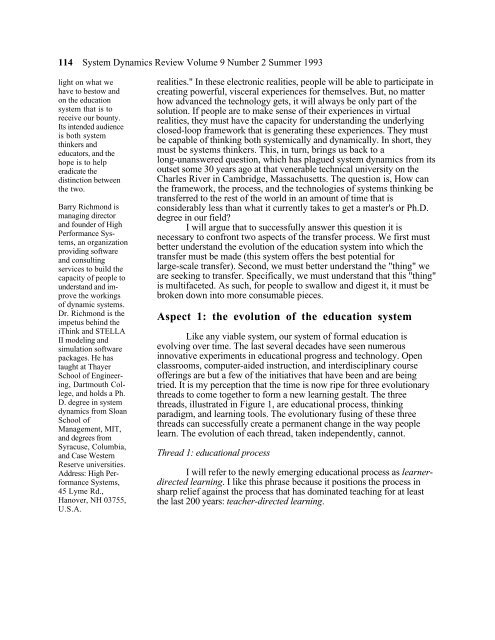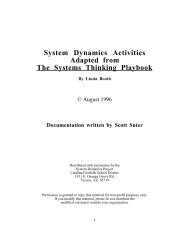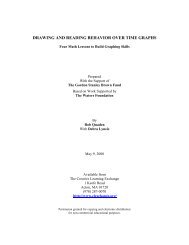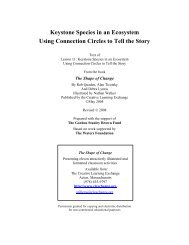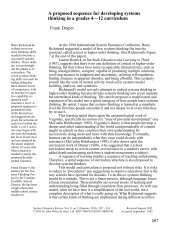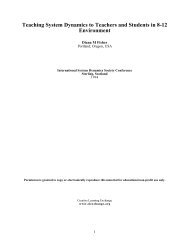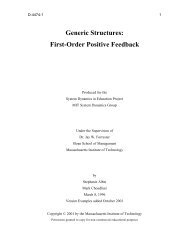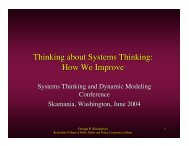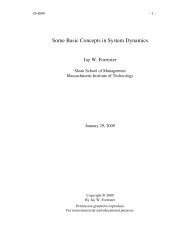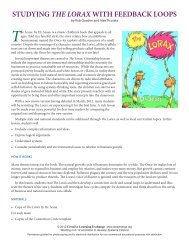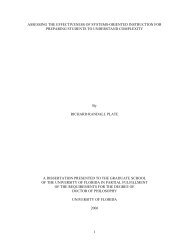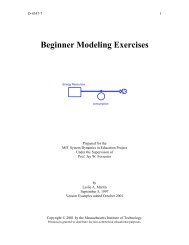Systems thinking: critical thinking skills for the 1990s and beyond
Systems thinking: critical thinking skills for the 1990s and beyond
Systems thinking: critical thinking skills for the 1990s and beyond
- No tags were found...
You also want an ePaper? Increase the reach of your titles
YUMPU automatically turns print PDFs into web optimized ePapers that Google loves.
114 System Dynamics Review Volume 9 Number 2 Summer 1993light on what wehave to bestow <strong>and</strong>on <strong>the</strong> educationsystem that is toreceive our bounty.Its intended audienceis both systemthinkers <strong>and</strong>educators, <strong>and</strong> <strong>the</strong>hope is to helperadicate <strong>the</strong>distinction between<strong>the</strong> two.Barry Richmond ismanaging director<strong>and</strong> founder of HighPer<strong>for</strong>mance <strong>Systems</strong>,an organizationproviding software<strong>and</strong> consultingservices to build <strong>the</strong>capacity of people tounderst<strong>and</strong> <strong>and</strong> improve<strong>the</strong> workingsof dynamic systems.Dr. Richmond is <strong>the</strong>impetus behind <strong>the</strong>iThink <strong>and</strong> STELLAII modeling <strong>and</strong>simulation softwarepackages. He hastaught at ThayerSchool of Engineering,Dartmouth College,<strong>and</strong> holds a Ph.D. degree in systemdynamics from SloanSchool ofManagement, MIT,<strong>and</strong> degrees fromSyracuse, Columbia,<strong>and</strong> Case WesternReserve universities.Address: High Per<strong>for</strong>mance<strong>Systems</strong>,45 Lyme Rd.,Hanover, NH 03755,U.S.A.realities." In <strong>the</strong>se electronic realities, people will be able to participate increating powerful, visceral experiences <strong>for</strong> <strong>the</strong>mselves. But, no matterhow advanced <strong>the</strong> technology gets, it will always be only part of <strong>the</strong>solution. If people are to make sense of <strong>the</strong>ir experiences in virtualrealities, <strong>the</strong>y must have <strong>the</strong> capacity <strong>for</strong> underst<strong>and</strong>ing <strong>the</strong> underlyingclosed-loop framework that is generating <strong>the</strong>se experiences. They mustbe capable of <strong>thinking</strong> both systemically <strong>and</strong> dynamically. In short, <strong>the</strong>ymust be systems thinkers. This, in turn, brings us back to along-unanswered question, which has plagued system dynamics from itsoutset some 30 years ago at that venerable technical university on <strong>the</strong>Charles River in Cambridge, Massachusetts. The question is, How can<strong>the</strong> framework, <strong>the</strong> process, <strong>and</strong> <strong>the</strong> technologies of systems <strong>thinking</strong> betransferred to <strong>the</strong> rest of <strong>the</strong> world in an amount of time that isconsiderably less than what it currently takes to get a master's or Ph.D.degree in our field?I will argue that to successfully answer this question it isnecessary to confront two aspects of <strong>the</strong> transfer process. We first mustbetter underst<strong>and</strong> <strong>the</strong> evolution of <strong>the</strong> education system into which <strong>the</strong>transfer must be made (this system offers <strong>the</strong> best potential <strong>for</strong>large-scale transfer). Second, we must better underst<strong>and</strong> <strong>the</strong> "thing" weare seeking to transfer. Specifically, we must underst<strong>and</strong> that this "thing"is multifaceted. As such, <strong>for</strong> people to swallow <strong>and</strong> digest it, it must bebroken down into more consumable pieces.Aspect 1: <strong>the</strong> evolution of <strong>the</strong> education systemLike any viable system, our system of <strong>for</strong>mal education isevolving over time. The last several decades have seen numerousinnovative experiments in educational progress <strong>and</strong> technology. Openclassrooms, computer-aided instruction, <strong>and</strong> interdisciplinary courseofferings are but a few of <strong>the</strong> initiatives that have been <strong>and</strong> are beingtried. It is my perception that <strong>the</strong> time is now ripe <strong>for</strong> three evolutionarythreads to come toge<strong>the</strong>r to <strong>for</strong>m a new learning gestalt. The threethreads, illustrated in Figure 1, are educational process, <strong>thinking</strong>paradigm, <strong>and</strong> learning tools. The evolutionary fusing of <strong>the</strong>se threethreads can successfully create a permanent change in <strong>the</strong> way peoplelearn. The evolution of each thread, taken independently, cannot.Thread 1: educational processI will refer to <strong>the</strong> newly emerging educational process as learnerdirectedlearning. I like this phrase because it positions <strong>the</strong> process insharp relief against <strong>the</strong> process that has dominated teaching <strong>for</strong> at least<strong>the</strong> last 200 years: teacher-directed learning.


